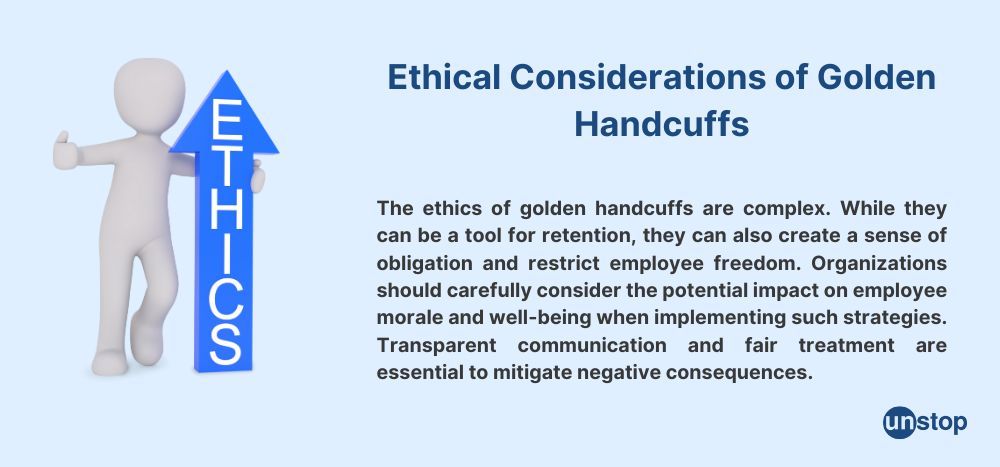- What Are Golden Handcuffs
- Purpose of Golden Handcuffs
- Types of Golden Handcuffs
- Real-World Examples
- Benefits of Golden Handcuffs
- Disadvantages of Golden Handcuffs
- Alternatives to Golden Handcuffs
- Closing Thoughts
- Frequently Asked Questions
Golden Handcuffs: Definition, Purpose, Types And Real-World Examples

The term "golden handcuffs" evokes images of wealth and security, but the reality can be more complex. This strategic HR tool is designed to incentivize employee retention through financial rewards and benefits. However, its impact on employee morale, productivity, and overall organizational culture can be multifaceted.
Let's delve into the world of golden handcuffs to understand their implications.
What Are Golden Handcuffs

Definition
Golden handcuffs refer to financial incentives aimed at keeping employees in their positions. Companies offer these benefits to discourage skilled workers from leaving. These incentives can include bonuses, stock options, or retirement plans that vest over time.
Target Audience
High-performing employees are the primary target for golden handcuffs. Employers focus on retaining individuals with specialized skills or knowledge. These employees often contribute significantly to a company's success and growth.
Psychological Impact
Golden handcuffs have a strong psychological effect on employees. They create a sense of obligation and loyalty toward the company. Employees may feel attracted to the financial benefits they would lose if they chose to leave. This can lead to indecision when considering job offers elsewhere.
Employees weigh the risks of losing their financial rewards against the potential benefits of a new position. The longer the vesting period for these incentives, the stronger the hold they have on an employee’s choices.
However, the fear of losing substantial earnings can also lead to employees feeling trapped, which can cause job dissatisfaction. This dynamic creates a complex relationship between motivation and retention.
Also Read: Top Employee Retention Strategies to Reduce Turnover in 2024.
Purpose of Golden Handcuffs
Employee Retention
Golden handcuffs aim to reduce employee turnover. Companies use these financial incentives to keep their top talent. Employees feel more secure when they know they have rewards waiting for them after a set period. This security can lead to increased job satisfaction and loyalty.
Competitive Advantage
By retaining skilled workers, companies maintain a competitive edge. Talented employees contribute significantly to a company's success. Their experience and knowledge create value that is hard to replace. Losing such individuals can be costly in both time and resources. Golden handcuffs help prevent this loss by encouraging employees to stay longer.
Long-Term Investment
Investing in employee retention strategies pays off in the long run. Employers save money on hiring and training new staff. They also benefit from improved team dynamics and productivity. A stable workforce fosters innovation and collaboration, which leads to better business outcomes.
Companies that implement golden handcuffs often see lower turnover rates. This stability allows them to build strong teams that work well together. As employees feel valued and appreciated, the workplace's overall morale improves.
Types of Golden Handcuffs
Bonuses
Bonuses are a common form of golden handcuffs. Companies often offer them to keep employees motivated. These bonuses usually depend on performance metrics. Employees may need to meet specific goals to qualify. Some bonuses require employees to stay for a certain period before receiving the full amount.
Stock Options
Stock options serve as another type of golden handcuff. They allow employees to purchase company shares at a set price. However, these options typically come with vesting periods. For example, an employee might have to wait four years before they can fully access their stock options. This encourages long-term commitment to the company.
Read all about the fundamentals of ESOPs (Employee Stock Options).
Contractual Obligations
Contractual obligations can also create golden handcuffs. Many companies include clauses in employment contracts that tie benefits to tenure. If an employee leaves before a specified date, they may lose bonuses or stock options. This strategy discourages turnover and promotes loyalty.
Real-World Examples
Golden Handcuff Options Vary Across Industries
Different industries use unique types of golden handcuffs tailored to their workforce. Tech companies often rely on stock options due to rapid growth potential. In contrast, financial firms may focus more on cash bonuses tied to quarterly performance. Each industry adapts its incentives based on what motivates its employees.
Technology Sector
Tech companies often use golden handcuffs to keep key employees. For instance, Google offers stock options to its engineers. These options vest over several years. Employees may think twice before leaving due to potential financial loss. This strategy has proven effective in retaining talent.
Financial Industry
In finance, firms like Goldman Sachs implement golden handcuff contracts. They provide bonuses tied to long-term performance. Employees receive incentives that depend on staying with the company for a set period. This approach helps maintain stability and encourages loyalty among top executives.
Benefits of Golden Handcuffs
Employer Advantages
Golden Handcuffs' two core advantages for employers are high retention (or low turnover) and lower hiring costs.
When companies keep valuable employees, they avoid the expenses associated with recruiting and training new staff. A loyal workforce results in enhanced team stability, which leads to better collaboration and productivity.
Retention bonuses are crucial to this strategy. By offering attractive compensation packages, companies can ensure that exceptional employees stay longer.
Employee Outcomes
Employees also gain from golden handcuffs. They enjoy increased financial security through bonuses and other financial rewards, which allow them to plan for the future more confidently. Career growth often follows as employers invest in their development. Companies may provide training or promotions as part of these incentives.
Golden handshakes and parachutes enhance this financial support further. Employees receive substantial payouts when leaving a company, ensuring they are financially secure during transitions.
Disadvantages of Golden Handcuffs
While golden handcuffs can be effective in retaining employees, they also come with potential drawbacks that organizations should consider carefully.
Reduced Employee Morale
Employees may feel trapped or undervalued if they perceive golden handcuffs as a form of control. When workers believe their employer is using financial incentives simply to keep them from leaving rather than genuinely valuing their contributions, it can create a sense of resentment. This feeling can lead to disengagement, where employees do the bare minimum instead of going above and beyond. A lack of enthusiasm can impact teamwork and overall productivity.
Focus on Short-Term Retention
Excessive reliance on golden handcuffs can neglect other factors that contribute to long-term employee satisfaction. While financial incentives might keep employees in their seats for a while, it does not address deeper issues such as career development, work-life balance, and workplace culture. If organizations focus only on the monetary aspect, they risk creating an environment where employees are dissatisfied with their roles, leading to high turnover once those incentives expire.
Potential Legal Issues
Certain golden handcuff arrangements may have legal implications, especially regarding employment contracts and non-compete clauses. If not structured properly, these agreements could lead to disputes or lawsuits if an employee decides to leave. Employers must ensure that their contracts are clear and compliant with local labor laws to avoid any legal challenges that could arise from misunderstanding or miscommunication about the terms.
Reduced Innovation
A fear of losing financial incentives may discourage employees from taking risks or exploring new opportunities. When employees feel that their job security hinges solely on staying within the company’s set boundaries, they might hesitate to propose innovative ideas or challenge the status quo. This lack of creativity can stifle progress and prevent the organization from adapting to changing market demands or discovering new solutions that could drive growth.
Understanding these potential drawbacks is crucial for companies looking to implement golden handcuffs effectively. Balancing financial incentives with a supportive work environment can lead to healthier employee relationships and sustained
Alternatives to Golden Handcuffs
Golden handcuffs should never be the only solution to employee retention. Here are some alternative strategies to foster employee loyalty and reduce turnover:
- Career Development Opportunities: Investing in employee growth and advancement can increase job satisfaction and commitment.
- Flexible Work Arrangements: Offering options like remote work, flexible hours, or compressed workweeks can improve work-life balance.
- Strong Company Culture: Building loyalty and belonging by fostering a positive company culture.
- Employee Recognition Programs: Recognizing and rewarding employee contributions can boost morale and motivation.
- Competitive Compensation and Benefits: Ensuring fair and favorable compensation packages is essential for attracting and retaining top talent.
Closing Thoughts
HR professionals must carefully consider the long-term implications of using golden handcuffs and balance their advantages with possible drawbacks. It is essential to incentivise top talent to stay with the company beyond just financial rewards.
Offering growth and development opportunities, creating positive work cultures, and encouraging open communication can cultivate a loyal and engaged workforce without solely relying on golden handcuffs. Ultimately, investing in the overall well-being and satisfaction of employees will lead to a more sustainable and fulfilling work environment for everyone involved.
Frequently Asked Questions
1. What are golden handcuffs?
Golden handcuffs are financial incentives that employers offer to retain employees. These can include bonuses, stock options, or other perks that are contingent on staying with the company for a certain period.
2. How do golden handcuffs work?
Golden handcuffs work by tying an employee's financial benefits to their tenure at the company. If they leave before a specified time, they may lose these benefits, creating a strong incentive to stay.
3. Who typically uses golden handcuffs?
Golden handcuffs are commonly used in industries like finance, technology, and for executive roles. Companies utilize them to keep top talent and prevent turnover.
4. What are the advantages of golden handcuffs for employees?
For employees, golden handcuffs can mean significant financial rewards. They often receive bonuses or equity that can enhance their overall compensation package if they remain with the company.
5. Are there any downsides to golden handcuffs?
Yes, the primary downside is reduced job mobility. Employees may feel trapped in their roles due to financial incentives, limiting their opportunities for career growth elsewhere.
6. Can golden handcuffs lead to job dissatisfaction?
Absolutely. While they offer financial security, they can also create resentment if employees feel forced to stay in a job that no longer aligns with their goals or values.
Suggested Reads:
- Job Enlargement: Definition, Benefits, And Implementation Process
- Balancing Dry Promotion With Talent Retention: A Detailed Guide For HRs
- Choosing The Best Competency Assessment Platform - Must-Have Features
- HR Guide To Employee Sabbatical Leave: Pros, Cons & Key Considerations
- What Are Technical Tests & Why Are They Popular Among Recruiters?
I’m a reader first and a writer second, constantly diving into the world of content. If I’m not writing or reading, I like watching movies and dreaming of a life by the beach.
Login to continue reading
And access exclusive content, personalized recommendations, and career-boosting opportunities.
Subscribe
to our newsletter
Blogs you need to hog!

Organize Hackathons: The Ultimate Playbook With Past Case Studies

What is Campus Recruitment? How To Tap The Untapped Talent?

Lateral Hiring: A Complete Guide To The Process, Its Benefits, Challenges & Best Practices














Comments
Add comment